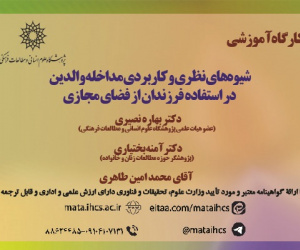نقدی بر تصحیح الصّراح من الصّحاح (مقاله علمی وزارت علوم)
درجه علمی: نشریه علمی (وزارت علوم)
آرشیو
چکیده
فرهنگ عربی فارسی الصّراح من الصّحاح یکی از آثار جمال الدین ابوالفضل محمد قَرشی و ترجمه ای ملخّص از تاج اللغه و صحاح العربیه اثر ابونصر اسماعیل بن حماد جوهری است. قرشی این کتاب را در سال 700ق در کاشغر ماوراء النهر به پایان رساند. محمدحسین حیدریان در سال ۱۳۹۷ش، الصّراح من الصّحاح را تصحیح و با ترجمه بخش های عربی آن منتشر کرد. در این مقاله، نخست از روش تصحیح صراح با دیدی انتقادی سخن رفته است. سپس اشتباهات و نادرست خوانی های مصحح با مراجعه به دو نسخه خطی مورد استفاده او، یک نسخه چاپ سنگی و صحاح جوهری، ذکر و صورت صحیح پیشنهادی ارائه شده است؛ در ادامه، اهمِّ اختلافات و ناهماهنگی های ضبط متن با ضبط نسخ، خصوصاً نسخه اساس، بررسی گردیده و در پایان به برخی از نقایص و کمبودهای متن چاپی در مقایسه با دستنویس ها اشاره شده است.A critique on the edition of Al-sorâh men al-sehâh
Arabic-Persian Al-sorâh men al-sehâh dictionary is one of Jamâl al-Din Abulfazl Mohammad Qarshi’s works and an abstract translation of Tâj al-Loghat and Sehâh al-Arabiyyat written by by Abu Nasr Ismail ben Hammâd Jowhari. Qarshi completed the book in 700 AH in Kâshghar located in Transoxiana. Mohammad Hoseyn Heydaryân edited and translated The Arabic parts in 1397 SH. In this article, first, the edition approach of Sorâh is reviewed. Then, the mistakes and misreads of the editor are mentioned on the basis of two manuscripts used by Heydaryân, one lithograph and Sehâh, and correct forms are proposed. Next, the main differences and mismatches between recording of the text and the recording of the manuscripts, specially the basic manuscript, are studied and finally, some of the flaws and deficiencies of the printed version in comparison to the manuscripts are mentioned. Keywords: Al-sorâh men al-sehâh, Jamâl Qarshi, Tâj al-Loghat and Sehâh al-Arabiyyat, Arabic-Persian dictionaries, Critical edition of texts, Edition Criticism. Arabic-Persian dictionary, Al-sorâh men al-sehâh, is one of the works of Jamâl al-Din Abulfazl Mohammad Qarshi (born in 628 AH, known as Jamâl Qarshi) and an abstract translation of Tâj al-Loghat and Sehâh al-Arabiyyat written by Abu Nasr Ismail ben Hammâd Jowhari (died 393 AH). Qarshi found a copy of Jowhari Sehâh in the library of Sâhebiye school in Transoxiana Kâshghar. He summarized the Sehâh and translated its vocabulary into Persian. He revised and completed Al-sorâh men al-sehâh in Kâshgar in 700 AH. In 1397 SH, Mohammad Hoseyn Heydaryân edited and published it in two volumes including the translation of its Arabic parts and indexes and explanations. In this article, we have criticized this edited text. For the critical review of this edition, all pages of the printed text were compared with the two manuscripts used by Heydaryân: the manuscript of the Khoy Namâzi school (number 42), which was the basic manuscript, and the manuscript of the Senate library (number 446). An authentic lithograph was also used. In many cases, Jowhari Sehâh's printed text was also referred to. In the following essay, first of all, Qarshi’s life has been briefly discussed. In the second part, the method of emendating and translating Sorâh has been examined with a critical view. In this section, it is mentioned that the editor did not record and present the differences between the versions and did not even bring one alternative version, and it is not clear which version/versions was used to correct the errors and omissions of the basic manuscript. The study of the manuscripts indicated that their differences often contain valuable phonetic, lexical and script information. Therefore, it is worth to say that not including the alternative version is one of the important shortcomings and weaknesses of this edition. In addition, it seems that the editor made a mistake in reading the date of writing of the basic manuscript. In the third part of the article, the slips and misreads of the editor have been mentioned and analyzed by referring to the versions. In this section, firstly, the entry containing the mistake, namely from the printed text, is quoted and the incorrect word(s) are identified, and then the correct form is suggested along with the necessary explanations and references. The suggested forms are mostly copied from the manuscripts, but in some cases these forms have been proposed using other sources, especially the printed text of Jowhari Sehâh and ancient Arabic-Persian dictionaries, and based on lexical and linguistic researches. The editor slips are mostly seen in the recording of Persian words and phrases, but mistakes are also seen in the Arabic parts. In this edition, some of the rarely used, old and precious Persian lexical units have been incorrectly recorded; words such as: baneye me'mâr, zâv, karbaš, xuse, balqonde, alej, patfuz, odarβan and nâvidan. This problem has caused the loss of some phonetic, linguis











